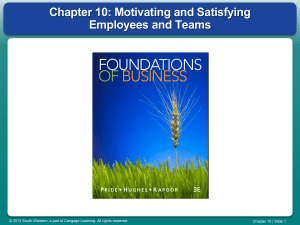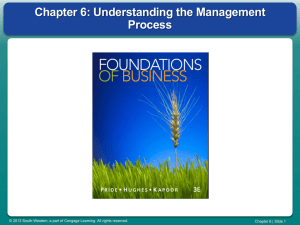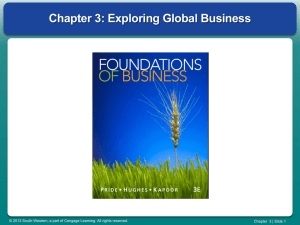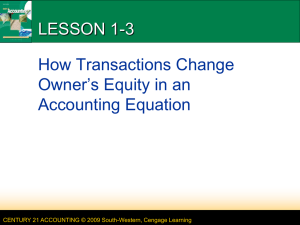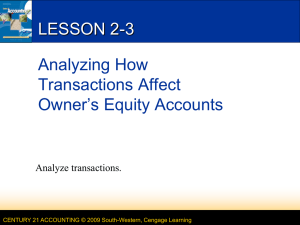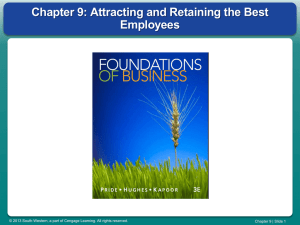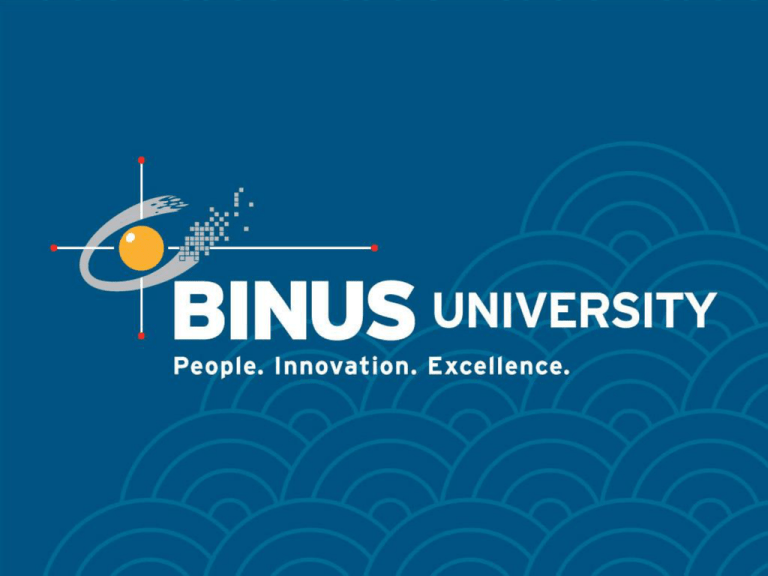
Matakuliah
Tahun
: J0124 – Manajemen Sumber Daya Manusia
: 2010
Job Design
5
Learning Outcomes
After studying this chapter, the students should be able to :
• Describe some job design concepts
• Describe the various factors that must be taken into account in
designing a job
Bina Nusantara University
3
Job Design
• Job Design
An outgrowth of job analysis that improves jobs
through technological and human considerations in
order to enhance organization efficiency and
employee job satisfaction.
• Job Enrichment (Herzberg)
Enhancing a job by adding more meaningful tasks
and duties (vertical expansion) to make the work
more rewarding or satisfying.
Providing opportunities for achievement,
recognition, growth, responsibility, and
performance.
© 2010 South-Western, a part of Cengage Learning. All rights reserved
FIGURE
4.3
Basis for Job Design
© 2010 South-Western, a part of Cengage Learning. All rights reserved
Job Enrichment Factors
• Increasing the level of difficulty and
responsibility of the job
• Allowing employees to retain more authority
and control over work outcomes
• Providing unit or individual job performance
reports directly to employees
• Adding new tasks to the job that require
training and growth
• Assigning individuals specific tasks, enabling
them to use their particular competencies or
skills
© 2010 South-Western, a part of Cengage Learning. All rights reserved
Job Characteristics
• Job Characteristics Model
(Hackman and Oldham)
Job design theory that purports that three
psychological states (experiencing meaningfulness
of the work performed, responsibility for work
outcomes, and knowledge of the results of the work
performed) of a jobholder result in improved work
performance, internal motivation, and lower
absenteeism and turnover.
© 2010 South-Western, a part of Cengage Learning. All rights reserved
Job Characteristics (cont’d)
1.Skill variety: The degree to which a job entails a variety of different
activities, which demand the use of a number of different skills and
talents by the jobholder
2.Task identity: The degree to which the job requires completion of a
whole and identifiable piece of work, that is, doing a job from beginning
to end with a visible outcome
3.Task significance: The degree to which the job has a substantial impact
on the lives or work of other people, whether in the immediate
organization or in the external environment
4.Autonomy: The degree to which the job provides substantial freedom,
independence, and discretion to the individual in scheduling the work and
in determining the procedures to be used in carrying it out
5.Feedback: The degree to which carrying out the work activities required
by the job results in the individual being given direct and clear
information about the effectiveness of his or her performance
© 2010 South-Western, a part of Cengage Learning. All rights reserved
Job Characteristics Model
• Job
Characteristics
• Psychological
States
• Job
Outcomes
Skill variety
Meaningfulness of
Improved work
Task identity
the work
performed
Responsibility for
work outcomes
Knowledge of the
results of the
work performed.
performance
Increased
Internal
motivation
Lower
absenteeism
and turnover
Task
significance
Autonomy
Feedback
© 2010 South-Western, a part of Cengage Learning. All rights reserved
Employee Empowerment
• Employee Empowerment
Granting employees power to initiate change,
thereby encouraging them to take charge of what
they do
Organizational conditions favoring empowerment:
Participation and autonomy
Innovation and acceptance
of risk-taking
Access to information
Accountability for results
Cultural openness to change
© 2010 South-Western, a part of Cengage Learning. All rights reserved
Industrial Engineering Considerations
• Industrial Engineering
A field of study concerned with analyzing work
methods and establishing time standards
• Ergonomics
An interdisciplinary approach to designing
equipment and systems that can be easily and
efficiently used by human beings
© 2010 South-Western, a part of Cengage Learning. All rights reserved
Designing Work for Group/Team Contributions
• Employee Involvement Groups (EIs)
Groups of employees who meet to resolve problems
or offer suggestions for organizational improvement
Also known as quality circles (QCs)
Success with EIs requires:
Comprehensive training for group members
Recognition of the group’s contributions
Continuing input and encouragement by management
Use of a participative/democratic leadership style
© 2010 South-Western, a part of Cengage Learning. All rights reserved
FIGURE
4.4
Computer Workstation Ergonomics Checklist
Use the following list to identify potential problem areas that should
receive further investigation. Any “no” response may point to a problem.
1. Does the workstation ensure proper worker posture, such as
• Thighs in the horizontal position?
• Lower legs in the vertical position?
• Feet flat on the floor or on a footrest?
• Wrists straight and relaxed?
2. Does the chair
• Adjust easily?
• Have a padded seat with a rounded front?
• Have an adjustable backrest?
• Provide lumbar support?
• Have casters?
3. Are the height and tilt of the work surface on which the keyboard is
located adjustable?
4. Is the keyboard detachable?
5. Do keying actions require minimal force?
6. Is there an adjustable document holder?
7. Are armrests provided where needed?
8. Are glare and reflections minimized?
9. Does the monitor have brightness and contrast controls?
10. Is there sufficient space for knees and feet?
11. Can the workstation be used for either right- or left-handed activity?
© 2010 South-Western, a part of Cengage Learning. All rights reserved
FIGURE
4.5
The Dynamics of Employee Involvement Groups
© 2010 South-Western, a part of Cengage Learning. All rights reserved
Employee Teams
• Employee Teams
An employee contributions technique whereby:
Work functions are structured for groups rather than for
individuals
Team members are given discretion in matters traditionally
considered management prerogatives, such as process
improvements, product or service development, and
individual work assignments.
© 2010 South-Western, a part of Cengage Learning. All rights reserved
Benefits of Employee Teams
• Increased integration of individual skills
• Better performance (quality and quantity)
solutions to unique and complex problems
• Reduced delivery time
• Reduced turnover and absenteeism
• Accomplishments among team members
© 2010 South-Western, a part of Cengage Learning. All rights reserved
How To Develop Team Synergy
Support
Focus on Quality
Listen and Clarify
SYNERGY
Consensus
Decision Making
Disagree
Constructively
Acceptance of
Member Skills
© 2010 South-Western, a part of Cengage Learning. All rights reserved
FIGURE
4.6
Synergistic Team Characteristics
Team synergy is heightened when team members engage in these positive behaviors.
• Support. The team exhibits an atmosphere of inclusion. All team members speak up
and feel free to offer constructive comments.
• Listening and Clarification. Active listening is practiced. Members honestly listen to
others and seek clarification on discussion points. Team members summarize
discussions held.
• Disagreement. Disagreement is seen as natural and is expected. Member comments
are nonjudgmental and focus on factual issues rather than personality conflicts.
• Consensus. Team members reach agreements through consensus decision-making.
Consensus decisions require finding a proposal that is acceptable to all team
members, even if not the first choice of individual members. Common ground among
ideas is sought.
• Acceptance. Team members are valued as individuals, recognizing that each person
brings a valuable mix of skills and abilities to team operations.
• Quality. Each team member is committed to excellent performance. There is emphasis
on continuous improvement and attention to detail.
© 2010 South-Western, a part of Cengage Learning. All rights reserved
Teamwork and Synergy
• Synergy
Occurs when the interaction and outcome of team
members is greater than the sum of their individual
efforts.
Synergistic team member behavior characteristics:
Is supporting and inclusive
Listens and clarifies
Disagrees but remains nonjudgmental
Engages in consensus building
Is accepting of others
Is focused on quality and continuous improvement
© 2010 South-Western, a part of Cengage Learning. All rights reserved
Forms of Employee Teams
• Cross-Functional Team
A group staffed with a mix of specialists (e.g.,
marketing, production, engineering) and formed to
accomplish a specific objective.
Cross-functional teams are based on assigned rather than
voluntary membership.
• Project Team
A group formed specifically to design a new product
or service. Members are assigned by management on
the basis of their ability to contribute to success.
The group normally disbands after task completion.
© 2010 South-Western, a part of Cengage Learning. All rights reserved
Forms of Employee Teams (cont’d)
• Self-Directed Team
Groups of highly trained individuals performing a
set of interdependent job tasks within a natural
work unit.
Team members use consensus decision making to perform
work duties, solve problems, or deal with internal or external
customers.
• Task Force Team
A task force is formed by management to
immediately resolve a major problem.
The group is responsible for developing a long-term plan for
problem resolution that may include a charge for
implementing the solution proposed.
© 2010 South-Western, a part of Cengage Learning. All rights reserved
Forms of Employee Teams (cont’d)
• Process-Improvement Team
A group of experienced people from different
departments or functions and charged with
improving quality, decreasing waste, or enhancing
productivity in processes that affect all
departments or functions involved. Team members
are normally appointed by management.
• Virtual Team
A group with widely dispersed members linked
together through computer and telecommunications
technology.
© 2010 South-Western, a part of Cengage Learning. All rights reserved
FIGURE
4.7
Forms of Employee Teams
Cross-Functional
Teams
A group staffed with a mix of specialists (e.g., marketing, production,
engineering) and formed to accomplish a specific objective. Crossfunctional teams are based on assigned rather than voluntary membership.
Project Teams
A group formed specifically to design a new product or service. Members
are assigned by management on the basis of their ability to contribute to
success. The group normally disbands after task completion.
Self-Directed Teams
Groups of highly trained individuals performing a set of interdependent job
tasks within a natural work unit. Team members use consensus decisionmaking to perform work duties, solve problems, or deal with internal or
external customers.
Task Force Teams
A task force is formed by management to immediately resolve a major
problem. The group is responsible for developing a long-term plan for
problem resolution that may include a charge for implementing the solution
proposed.
Process-Improvement
Teams
A group made up of experienced people from different departments or
functions and charged with improving quality, decreasing waste, or
enhancing productivity in processes that affect all departments or functions
involved. Team members are normally appointed by management.
© 2010 South-Western, a part of Cengage Learning. All rights reserved
Characteristics of Successful Teams
• Commitment to shared goals and objectives
• Motivated and energetic team members
• Open and honest communication
• Shared leadership
• Clear role assignments
• Climate of cooperation, collaboration, trust,
and accountability
• Recognition of conflict and its positive
resolution
© 2010 South-Western, a part of Cengage Learning. All rights reserved
Obstacles to Effective Team Function
• Overly high expectations
• Group compensation
• Training
• Career movement
• Power
© 2010 South-Western, a part of Cengage Learning. All rights reserved
Training Team Members
• Complete skills training in:
Team leadership
Mission/goal setting
Conduct of meetings
Team decision making
Conflict resolution
Effective communication
Diversity awareness
© 2010 South-Western, a part of Cengage Learning. All rights reserved
Flexible Work Schedules
• Compressed Workweek
Shortening the number of days in the workweek by
lengthening the number of hours worked per day.
The four-day, forty-hour week, generally referred to as 4/10
or 4/40.
Reducing weekly hours to 38 or 36 hours or scheduling 80
hours over nine days (9/80), taking one day off every other
week.
© 2010 South-Western, a part of Cengage Learning. All rights reserved
Flexible Work Schedules
• Benefits
Recruitment and retention
of employees
Coordinating employee
work schedules with
production schedules
Accommodating the
leisure-time activities of
employees while
facilitating employee
personal appointments
• Disadvantages
Overtime payments
required by the Fair Labor
Standards Act for
employees working over 40
hours in one week.
The additional stress on
managers and employees,
and long workdays can be
exhausting.
Improvements in employee
job satisfaction and morale
© 2010 South-Western, a part of Cengage Learning. All rights reserved
Flexible Work Schedules
• Flextime
Working hours that permit employees the option of
choosing daily starting and quitting times, provided
that they work a set number of hours per day or
week.
All employees are required to be present during a
designated “core period.”
Flexible hours reduce absenteeism and tardiness.
Employees can schedule their working hours for the
time of day when they are most productive.
© 2010 South-Western, a part of Cengage Learning. All rights reserved
3
How to Request a Flexible Work Schedule
You may be thinking, “My manager would never agree to a flexible work schedule.” But that’s not
necessarily so. When valued employees make reasonable scheduling requests, managers often try
to accommodate employee proposals. Here are some proven strategies for securing different types
of flexible work hour arrangements.
• Investigate. Look into similar arrangements others have made within your company or industry.
Research company policy. Be realistic by providing a schedule that will fit the demands of your
organization.
• Be Professional. Treat your request as a business proposal. Be positive and assume a “can-do”
attitude.
• Be serious and present the proposal as a benefit to both you and your company. Present your
idea as a “win-win” arrangement.
• Write It Out. Submit your request for a flexible work hour arrangement in a well-organized,
detailed written proposal.
• Promote Yourself. Explain your value to your organization. Have others speak to your abilities—
especially those in authority. Ask to be evaluated based on your quantity and quality of work
rather than on the hours you actually spend on the job.
• Anticipate Questions. Be prepared for potential problems and have specific answers on how to
deal with these issues. For example, how you will communicate or coordinate with other
employees.
• Propose a Review. Propose review dates to evaluate your new flexible schedule. Continually
assess how you work with others and your manager.
© 2010 South-Western, a part of Cengage Learning. All rights reserved
Flexible Work Schedules
• Job Sharing
The arrangement whereby two part-time employees
perform a job that otherwise would be held by one
full-time employee.
Job sharers may work three days a week, creating
an overlap day for extended face-to-face
conferencing.
• Telecommuting
The use of personal computers, networks, and other
communications technology such as fax machines to
do work in the home that is traditionally done in
the workplace.
© 2010 South-Western, a part of Cengage Learning. All rights reserved
Advantages of Telecommuting
• Increased flexibility for employees
• Ability to attract workers who might not
otherwise be available
• Lessened burden on working parents
• Less time and money wasted on physical
commuting
• Increased productivity
• Reduced absenteeism
© 2010 South-Western, a part of Cengage Learning. All rights reserved
FIGURE
4.8
Keys for Successful Telecommuting
• Identify jobs best suited to distance work.
• Select responsible employees.
• Establish employee feedback procedures and
performance review methods for evaluation.
• Establish formalized telecommuting procedures.
• Begin a formal training program.
• Keep telecommuters informed and “in the loop.”
• Recognize when telecommuting isn’t working.
© 2010 South-Western, a part of Cengage Learning. All rights reserved

